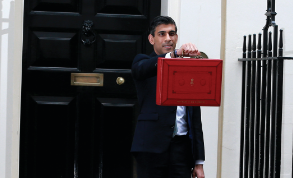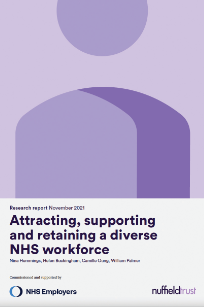News / News review – December 2021
The past few months have been dominated by decisions on NHS spending in England – both for the second half of the 2021/22 financial year, and for the next three years – as the government delivered its spending review in October. Most of the health spending news was released in September, with the government allocating an additional £5.4bn in England for the final six months of the current financial year. This includes £2.8bn to cover Covid costs, while £1bn has been set aside to continue elective recovery. There was also £478m for the discharge to assess programme, and £500m in capital funding for additional theatre capacity and technology that will increase productivity. A further £600m was allocated for ‘day-to-day’ costs.

Looking further ahead, the government said NHS England would benefit from extra funding of almost £16bn over the three years to 2024/25, with social care receiving an extra £5.4bn. The NHS will receive £9bn over three years to tackle elective recovery, with the target of increasing activity to 30% above pre-pandemic levels. There will also be funding for technology that will aid elective recovery and hospital and theatre productivity (both £250m). The spending will be paid for with a 1.25 percentage point increase in National Insurance from April 2022 – which will subsequently become a health and care levy on earnings from 2023. There will also be a 1.25 percentage point rise in dividend tax rates. Overall, health spending will grow by £36bn over the three years, including Barnett consequentials for the devolved administrations (£5.7bn).
November’s Budget and spending review confirmed these rises, setting overall capital spending at £10.6bn, £10.4bn and £11.2bn respectively for the coming three years, compared with £9.4bn in the current year. There was no detail on specific Health Education England (HEE) budgets, but the government committed to ‘building a bigger, better trained NHS workforce’ and providing ‘hundreds of millions of pounds in additional funding’ to underpin this.
Subsequently, the government announced that HEE would merge with NHS England and NHS Improvement, insisting that the merger would put long-term planning for healthcare recruitment and retention at the forefront of the national agenda. HEE said the merger would bring finance and service planning together with workforce planning and development. NHS Digital and NHSX will also merge with NHS England and NHS Improvement.
Additional funding was announced in Scotland and Northern Ireland. The Scottish government allocated a further £482m to NHS boards and integration authorities to meet the costs of the pandemic and remobilising health services. The sum includes £121m for Test and Protect and £136m for the vaccination programme. The rest of the funding will cover additional staffing to support hospital scale-up, equipment, maintenance and IT.
Health and personal social services in Northern Ireland were allocated a further
£200m this year. Finance minister Conor Murphy said that the administration’s share of Barnett consequentials from the NHS spending rise in England for the rest of 2021/22 had not been confirmed. However, he had made the allocation to ensure local health and social services receive the funding as soon as possible. Mr Murphy said £80m will be spent addressing Covid-19 hospital service pressures; there will be an extra £70m to cover the 3% pay award; £30m to address elective care pressures; £15m for health and social care trusts; and £5m for the Mental Health Support Fund.
While attention has been drawn to the Covid pandemic and the government’s spending plans, some NHS staff have been unsettled over their pay awards for 2021/22. The Royal College of Nursing has held indicative ballots on industrial action in England, Scotland and Wales. In Scotland, nine in 10 RCN members backed industrial action short of a strike, while 60% supported strike action. They had rejected the 4% offer in May. The union said it would use the result to consider its next steps.
In England, 89% were willing to take action short of a strike, while 54% would withdraw their labour. The strength of feeling was similar in Wales, with 91% voting for industrial action but not a strike, and 56% backing a strike. The union will now consider its next steps. In October, 90% of Unite union members in England rejected the 3% award in a consultative ballot, with 84% willing to take industrial action. However, the turnout was not enough to meet the threshold for industrial action. The British Medical Association said junior doctors will intensify their pay campaign after they were not included in the 3% increase – juniors are part of a multi-year pay agreement and have received a 2% pay rise.
Workforce – both shortages and the need to plan for the future – was a theme that has run through the past three months. An amendment to the Health and Care Bill, backed by more than 60 health and care organisations, which would have required government to publish independent annual assessments of current and future workforce needs, was rejected by MPs. In a joint survey, the Royal College of Physicians, the Royal College of Physicians of Edinburgh, and the Royal College of Physicians and Surgeons of Glasgow found the proportion of vacant medical consultant posts across the UK is at the highest level in almost a decade. The survey showed nearly half (48%) of advertised posts were unfilled last year, an increase of 12 percentage points since 2013. Lack of applicants was the main reason the posts were vacant (49%), while 34% were not filled due to a lack of suitable candidates.

A Nuffield Trust analysis showed the number of full-time equivalent nurses rose by 14,158 in the last two years. It said that ‘on the face of it, this appears to be the right level of growth’ to achieve the government’s manifesto commitment of a 50,000 increase by 2025. However, it warned against complacency, and said there was no precedent for such a sustained increase. An annual increase of 10,000 more nurses has only been achieved four times in 62 years.
The NHS does not have the tools to address inequality between NHS staff groups, according to a Nuffield Trust report. It said that despite considerable effort, inequality may even have got worse. Attracting, supporting and retaining a diverse workforce, commissioned by NHS Employers, said there was a lack of data, less-high-profile groups are being overlooked, and there is poor understanding of what works to improve diversity. Lack of inclusion meant worse patient care and hindered the NHS ability to recruit and retain staff, it added.
QUOTES
Northern Ireland finance minister Conor Murphy sets aside funding for staff pay rises
‘We expect 41% of UK consultants to retire over the next decade. The opportunity to take a long-term approach to prepare for these challenges ahead has been missed.’
Royal College of Physicians president Andrew Goddard laments MPs’ rejection of proposed changes to the Health and Care Bill
 ‘This funding will go straight to the frontline to provide more patients with the treatments they need but aren’t getting quickly enough. We will continue to make sure our NHS has what it needs to bust the Covid backlogs and help the health service build back better from the worst pandemic in a century.’
‘This funding will go straight to the frontline to provide more patients with the treatments they need but aren’t getting quickly enough. We will continue to make sure our NHS has what it needs to bust the Covid backlogs and help the health service build back better from the worst pandemic in a century.’
Boris Johnson pledges financial support for the NHS
‘This report highlights action that is being taken but rightly reminds us that far more urgency and impact is needed in every part of the NHS.’
The NHS must act now to tackle discrimination, says NHS Employers chief executive Danny Mortimer
From the HFMA
 With the UN’s COP26 climate conference taking place in Glasgow, the HFMA provided a wide range of briefings, webinars, and blogs supporting members to play a role in making the NHS environmentally sustainable. In a blog, association chief executive Mark Knight outlined the HFMA’s own actions, including switching the magazine’s packaging from plastic to recyclable paper and an environmentally friendly printing process. The HFMA published its green pledges, and is taking the opportunity to embed sustainability in its new Bristol headquarters.
With the UN’s COP26 climate conference taking place in Glasgow, the HFMA provided a wide range of briefings, webinars, and blogs supporting members to play a role in making the NHS environmentally sustainable. In a blog, association chief executive Mark Knight outlined the HFMA’s own actions, including switching the magazine’s packaging from plastic to recyclable paper and an environmentally friendly printing process. The HFMA published its green pledges, and is taking the opportunity to embed sustainability in its new Bristol headquarters.
HFMA policy and communications director Emma Knowles blogged about the autumn Budget and spending review, while Health Foundation research director Anita Charlesworth urged the health service to make more payment reforms beyond the implementation of the aligned payment and incentive system to be introduced in 2022.
See blogs and publications
Related content
We are excited to bring you a fun packed Eastern Branch Conference in 2025 over three days.
Mindset and the neuroscience of leadership - Lunch and Learn